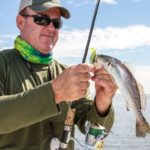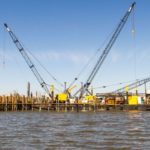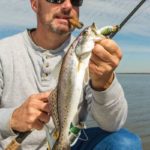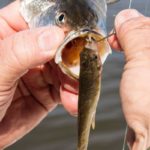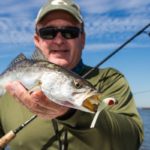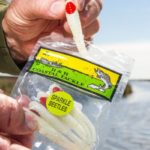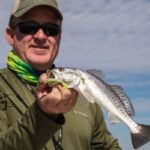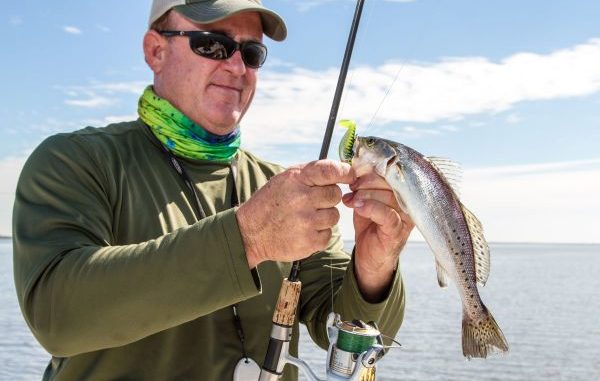
Timbalier Island is where big trout live this month, but sometimes the weather is too ugly to fish it. Don’t stay home — instead head to Catfish Lake.
Lots of folks launch at the Oak Ridge Park boat ramp in Golden Meadow during April. A great percentage of them aspire to fish East Timbalier. And why not? April means transition trout, and East Timbalier is the end of the line.
But as most of these anglers have figured out the last few Aprils, it’s a rare day when the wind cooperates.
Fortunately for them, all these transition trout don’t vacate the inside en masse.
And while many Golden Meadow trout may have already left, there are enough specks from Galliano to Larose to fill the void.
And many of them make a stopover in Catfish Lake.
“Catfish Lake is one of those kinds of spots where trout constantly move into and out of during April,” said Capt. Don Bordelon with Don “Dee’s” Bayou Coastal Guide Service (985-291-2464).
In other words, Catfish Lake is a layover spot where anglers intent on fishing East Timbalier can still catch fish when the weather man gets it wrong.
Boy, did he ever get it wrong.
I was supposed to meet Bordelon and his buddy Troy Terrebonne at Oak Ridge Park boat ramp on a Sunday morning.
Unfortunately, the weather man had predicted an 80-percent chance of thunderstorms along the coast of Lafourche Parish.
Seeing as how I had just been on the end of an indirect lightening strike two days before, I wasn’t in the mood to dodge thunderstorms.
We settled on a Wednesday morning three days later.
“Man, you should have been here Sunday,” Bordelon joked, as I stepped into his Pathfinder bay boat. “It was perfect conditions. We could have easily made it down to East Tim. In fact, all the boats I know that went out Sunday had 60 to 70 trout.”
Indigestion began to sink in as I saw the wind buffeting Bordelon’s shirt.
That all-to-familiar, sinking feeling that this trip was going to be more work than fun began to settle into the pit of my stomach.
“Check out how high the water was yesterday,” Bordelon instructed, while pointing toward some broken vegetation that was crusting on dry concrete about four feet up the ramp.
Thanks to the Lenten winds, there was hardly any water to fish.
“And the tide is supposed to be falling all day long,” Bordelon lamented as we idled away from the ramp. “No doubt, it’s a suck day.”
Bordelon would typically begin an April day by running all the way to the islands and working his way back toward Golden Meadow.
However, that was out of the question, so he ran through Catfish Lake to try a big duck pond just off Bayou Blue a little south of Catfish Lake.
A “crayvay” he called it.
He expected trout to be stacked up and hitting bait where the edge of the pond dropped off into an old pipeline canal.
We were all rigged up with chartreuse-colored Renosky Super Shad soft-plastic baits hanging about 2 feet under some Pogeaux Pop corks.
Terrebonne called the Renosky soft plastic hanging on his line a Bute Bait.
“Thibodaux’s Grocery was a neighborhood grocery, bar, tackle shop and hunting store in Cut Off,” he said. “It’s nickname was the Bute. The hot fresh or saltwater bait was always called the Bute Bait because that is where most locals would go to buy the lures. Now it’s mostly just a bar.”
Although he had tied on a handful of Bute Baits, Bordelon also had handy a bag or two of the old standard sparkle beetles.
“I normally use smoke and off-white split-tail beetles,” Bordelon told me as he made his first cast, “but we had the west wind blowing at 15 to 20 knots with gusts to 30 yesterday.
“I thought we’d give them something chartreuse to give them a little better chance of picking up in the stained water.”
Unfortunately, it didn’t matter what we threw because the trout were just not there.
We bounced around a couple of other shallow ponds trying to get on some redfish, but the water was just too low.
We even made the run north to the Sulphur Mine, only to hear a lone angler griping about not having had a bite all morning.
Lake Bully Camp held a few fish, but the action was as slow as it was inconsistent —although it at least got the monkey off our backs.
That left Catfish Lake.
“Should have started here in the first place,” Bordelon surmised after reeling in his first speckled trout.
It wasn’t anything to write home about, but the single 14-inch trout ushered in a span of an hour or two when we actually got to watch our corks disappear under the water.
“If you get down here and it’s really windy, you can just start in Catfish Lake,” Bordelon said. “It’s got a lot of shell reefs and oyster beds in areas where you can get out of the wind and have a suitable place to fish.”
Bordelon theorized that one of the reasons Catfish Lake was so good during the April transition was that it served as a giant nursery of sorts for bait.
“This is a big estuary up here where shrimp grow before they make their push south,” he explained. “Fish come in to meet the shrimp and pretty much hang around them, croaker, pogies and mullet.
“All this bait starts its life in the ponds around Catfish Lake, so it’s a natural that the fish want to be in here eating on them.”
Although the bait might be small during April — Bordelon estimated that the shrimp would be in the 100- to 150-count range — that doesn’t mean the trout are small, too.
Needless to say, you’re probably not going to catch giant fish around Catfish Lake, but if a limit of 14- to 17-inch trout sounds fine, then size apparently doesn’t matter.
“Every now and then we get some nice catches,” Bordelon noted. “Maybe a third to half your catch might average 2 to 2½ pounds. Now if you can get down to the islands, you’re looking at 4- to 5-pound trout.”
A big difference, indeed, but if you can’t get to the big trout or the wind messes you up once you get there, why bother?
“With all the coastal erosion, it’s really open down there,” Terrebone said. “It doesn’t take but a 10- or 15 mph wind to really stir up the water down there. We get a lot of rough conditions during April.”
Terrebonne, who grew up playing in the marshes around Catfish Lake, explained that the lake is a great mix of fish-holding features that help it attract trout no matter the time of year.
“There are different reefs out there to the south and northeast,” he said. “The rigs have shell pads, and there is a pretty good oyster bed on the east side of the tank battery that can hold trout and a couple of big reds.”
A lot of little flats make up the south corner where several bayous run out of the marsh. Trout sometimes bite topwaters really early in the morning on that side of the lake.
On the north side, there are a lot more duck ponds that have eroded out, so there are a lot more oyster beds there.
“Catfish Lake is a good estuary for the hatching of shrimp because of the marsh all around the area that drain into it,” Terrebonne explained. “Then you got all the deeper bayous going out — perfect place for bait and the fish that eat it.”
There is a lot of new construction in Catfish Lake, though. When the price of natural gas was really high five years ago, that’s when it paid to overhaul some of the wells and work them out.
“Now that the gas prices went way down,” Bordelon said, “it’s just sitting gearing up when they going to run them again. Most are natural gas wells. But they really don’t hamper the fishing at all because they just working specific areas. They’re not overwhelming the lake.”
That’s because Catfish Lake is pretty substantial: Bordelon estimated it to be maybe 2 ½ miles across.
But the most-important number about Catfish Lake is that it is only a six-minute boat run from Oak Ridge Park boat ramp through protected canals.
East Timbalier might be the end of the transition line, but Catfish Lake is the long-lasting, weatherproof layover that holds trout as they make their way down that line.
And during April, especially, you’re going to need a weather-proof place to fish when conditions turn bad.
